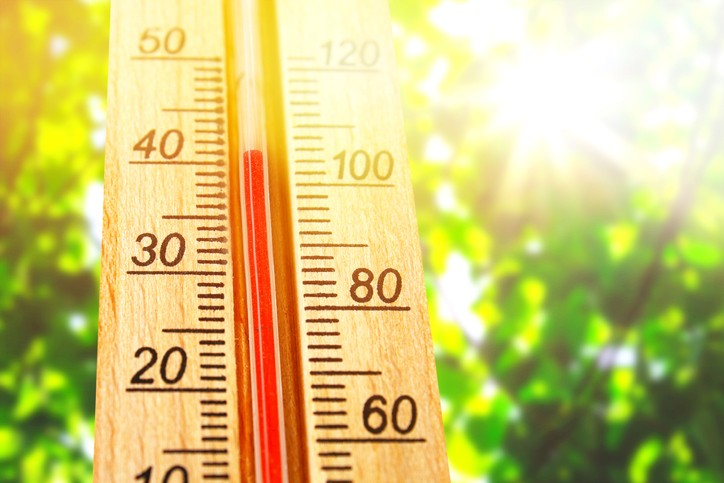
New England summers can be the best, but let’s face it, summers in Connecticut have the potential to be hotter than what’s desirable. With summer comes more time outside, making it important to know the signs of heat stroke, actions to take if you notice these symptoms, and what you can do to help prevent heat stroke.
For athletes in particular, who are more physical outside in the sweltering heat, heat stroke is of greater concern. According to the University of Connecticut’s Korey Stringer Institute, heat stroke is one of the top causes of sudden death among athletes. A recent CDC study reported over eight thousand heat related deaths during a 10 year period, nearly 40 percent of which occurred during the month of July.
What is Heat Stroke?
Humans are endothermic (warm-blooded) animals. This classification means that under normal conditions your body automatically regulates its temperature. You have many mechanisms to accomplish this task, such as thirst, body fat, sweating, and changes in blood flow. However, environmental conditions or dehydration can move your body temperature outside of its norm.
When your temperature becomes too high, the condition is called hyperthermia or as it is more commonly known, heat stroke or sunstroke. Heat stroke is a serious condition that can cause major organ damage or even death. It requires emergency medical treatment. Fortunately, there are ways to prevent heat stroke and signs that the condition is imminent.
Heat Stroke Symptoms
Heat stroke often comes on during exertion in a hot environment. For example, playing a game of basketball on the hot blacktop during a summer’s day puts you at risk of heat stroke. However, while exertion may hasten heat stroke, you can still suffer from this condition at rest. For instance, simply sunbathing may result in heat stroke if you are not careful.
Whether exercising or at rest, here are signs of heat stroke:
- – High body temperature, 104 degrees Fahrenheit (40 degrees Celsius) or greater by rectal thermometer
- – Headache
- – Fast heart rate
- – Red or flushed skin, particularly on the face and neck
- – Nausea and/or vomiting
- – Excessive sweating or complete lack of perspiration
- – Changes in mental state such as delirium, sleepiness, confusion, slowed responses, and nonsensical speech
Even a fit person in the prime of their life may fall victim to heat stroke, but some groups are more susceptible to the problem. Young children and the elderly are particularly prone to heat stroke as their nervous systems are not as robust as others. These people should be watched closely for signs of heat stroke and be offered shade and ample water.
Heat Stroke Treatment
Observing any of the signs and symptoms listed above in a hot environment is cause for emergency action. Call 911 immediately, and then get the patient into cooler surroundings. An air-conditioned spot indoors is best, but even a cooler area outdoors will do. Try to move the victim beneath shade.
Next, remove any extra clothing, including outerwear, hats, shoes and socks. The idea is to have as much of the person’s skin exposed to the air as possible. Then, concentrate on cooling the victim further by fanning them, applying ice or cold packs to their skin (particularly in the armpits and groin area), and placing cool, moist towels on their neck and forehead. Allow the victim to lie down and offer them water, but do not force them to drink. Remember, heat stroke can cause progressive organ damage, so time is of the essence.
Preventing Heat Stroke
You can help prevent heat stroke by taking precautions and being aware of your body’s condition. Since exertion increases your chances of suffering heat stroke, try to avoid outside activity during the hottest part of the day. Temperatures typically peak in the late afternoon. If you must do yard work or want to go for a run outside, perform your activity in the early morning or late evening to spare yourself from the brunt of the heat.
Always stay hydrated. Drink plenty of water, frequently. While water is probably the best beverage to stave off heat stroke, sports drinks can also be helpful. And while alcoholic beverages may seem refreshing in the heat, they actually contribute to dehydration.
Take frequent breaks. Whether you are doing work or playing a sport, you need more rest in the heat. Do not push yourself too hard, and stop at the first sign of lightheadedness, shortness of breath or dizziness.
Finally, you should be aware that certain medications can make you more susceptible to heat stroke as they interfere with your body’s ability to regulate temperature. These drugs include several classes of blood pressure medications, antidepressants and diuretics (water pills). Ask your primary care doctor whether any of your medications increase the risk of heat stroke and follow their recommended precautions.
Looking For a Primary Care Doctor in Connecticut?
PACT Primary Care is Accepting New Patients!
Locations throughout Connecticut in Guilford, Hamden, Madison, Milford, New Haven, Orange, West Haven and Wallingford.
To schedule an appointment, request an appointment online here or call a local center near you.

